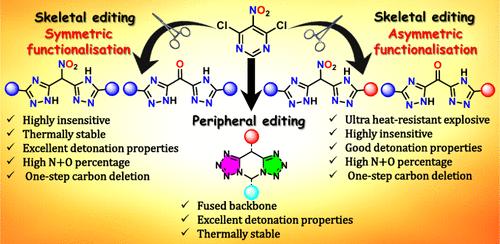Skeletal Editing of Energetic Materials: Acid-Catalyzed One-Step Synthesis of Bridged Triazoles as High-Energy-Density Materials via the Nef Reaction
IF 5.4
2区 医学
Q2 MATERIALS SCIENCE, BIOMATERIALS
引用次数: 0
Abstract
Thermally stable insensitive energetic materials have captivated significant attention from the global research community due to their potential impact. In this study, a series of symmetric and asymmetric nitromethyl-bridged triazole compounds were synthesized from pyrimidine moieties via a skeletal editing approach. Additionally, carbonyl-bridged compounds were synthesized in a single step by using acid-catalyzed Nef reactions from their nitromethyl precursors. Peripheral modifications of pyrimidine resulted in fused energetic moieties. All synthesized compounds were fully characterized by using infrared spectroscopy, high-resolution mass spectrometry, multinuclear magnetic resonance spectroscopy, elemental analysis, and differential scanning calorimetry. Single-crystal X-ray diffraction analysis confirmed the structures of compounds 4 and 10. The newly synthesized moieties exhibit densities ranging from 1.75 to 1.86 g cm–3, detonation velocities between 8044 and 8608 m s–1, and detonation pressures between 23.10 and 30.31 GPa. Notably, compounds 9 and 10 demonstrate exceptional heat resistance, with decomposition temperatures of 315 and 335 °C, respectively. Computational studies, including density functional theory, quantum theory of atoms in molecules, noncovalent interactions, and electrostatic surface potential analysis, account for hydrogen-bonding and noncovalent interactions. This work highlights the potential of skeletal editing in the development of high-performing, thermally stable energetic materials.

高能材料的骨架编辑:通过 Nef 反应,酸催化一步合成桥式三唑类高能量密度材料
热稳定不敏感的高能材料因其潜在的影响而备受全球研究界的关注。本研究通过骨架编辑方法,从嘧啶分子合成了一系列对称和不对称的硝甲基桥接三唑化合物。此外,还利用酸催化 Nef 反应从硝甲基前体一步合成了羰基桥接化合物。嘧啶的外围修饰产生了融合的高能分子。利用红外光谱、高分辨率质谱、多核磁共振波谱、元素分析和差示扫描量热法对所有合成化合物进行了全面鉴定。单晶 X 射线衍射分析证实了化合物 4 和 10 的结构。新合成的分子密度在 1.75 至 1.86 g cm-3 之间,爆速在 8044 至 8608 m s-1 之间,爆压在 23.10 至 30.31 GPa 之间。值得注意的是,化合物 9 和 10 表现出卓越的耐热性,分解温度分别为 315 ℃ 和 335 ℃。计算研究包括密度泛函理论、分子中原子的量子理论、非共价相互作用和静电表面势分析,这些研究解释了氢键和非共价相互作用。这项研究成果凸显了骨架编辑在开发高性能、热稳定性高能材料方面的潜力。
本文章由计算机程序翻译,如有差异,请以英文原文为准。
求助全文
约1分钟内获得全文
求助全文
来源期刊

ACS Biomaterials Science & Engineering
Materials Science-Biomaterials
CiteScore
10.30
自引率
3.40%
发文量
413
期刊介绍:
ACS Biomaterials Science & Engineering is the leading journal in the field of biomaterials, serving as an international forum for publishing cutting-edge research and innovative ideas on a broad range of topics:
Applications and Health – implantable tissues and devices, prosthesis, health risks, toxicology
Bio-interactions and Bio-compatibility – material-biology interactions, chemical/morphological/structural communication, mechanobiology, signaling and biological responses, immuno-engineering, calcification, coatings, corrosion and degradation of biomaterials and devices, biophysical regulation of cell functions
Characterization, Synthesis, and Modification – new biomaterials, bioinspired and biomimetic approaches to biomaterials, exploiting structural hierarchy and architectural control, combinatorial strategies for biomaterials discovery, genetic biomaterials design, synthetic biology, new composite systems, bionics, polymer synthesis
Controlled Release and Delivery Systems – biomaterial-based drug and gene delivery, bio-responsive delivery of regulatory molecules, pharmaceutical engineering
Healthcare Advances – clinical translation, regulatory issues, patient safety, emerging trends
Imaging and Diagnostics – imaging agents and probes, theranostics, biosensors, monitoring
Manufacturing and Technology – 3D printing, inks, organ-on-a-chip, bioreactor/perfusion systems, microdevices, BioMEMS, optics and electronics interfaces with biomaterials, systems integration
Modeling and Informatics Tools – scaling methods to guide biomaterial design, predictive algorithms for structure-function, biomechanics, integrating bioinformatics with biomaterials discovery, metabolomics in the context of biomaterials
Tissue Engineering and Regenerative Medicine – basic and applied studies, cell therapies, scaffolds, vascularization, bioartificial organs, transplantation and functionality, cellular agriculture
 求助内容:
求助内容: 应助结果提醒方式:
应助结果提醒方式:


